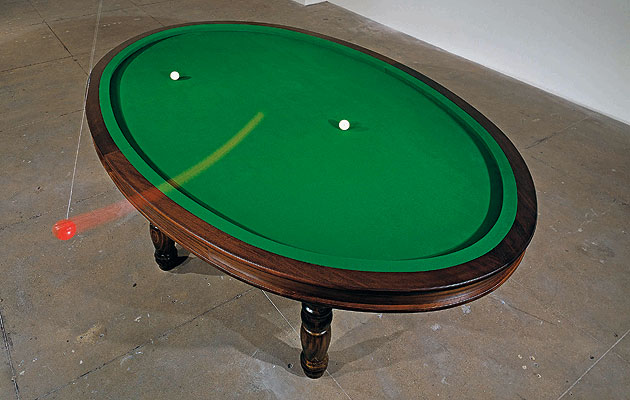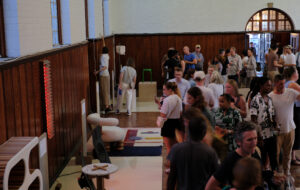|
|
||
|
Commentators who have called Gabriel Orozco the defining artist of the 1990s have him right – although it is, of course, a double-edged compliment. The globetrotting Mexican artist effectively patented the approach that tied together the decade’s hyper-pluralism: nomadic, intellectually fidgety, post-medium, post-studio. With a 1990s revival now gathering steam in other corners of culture, this retrospective of Orozco’s work from 1990 to 2010 seems timely. It’s also an opportunity for those of us who have only seen discrete extracts from his tireless production to try and discern – if they exist – some of the themes beneath his overarching geographical and formal restlessness. Exist they do: Orozco’s art here comes across as a perpetually playful, admirably inventive gaming with a stolid reality, the ultimatecertainty of which is the extinction of life. His iconic Black Kites (1997), a human skull patiently decorated with a pencilled checkerboard, seems to collapse the chess-match-with-Death scenario of Ingmar Bergman’s The Seventh Seal into a single, sanguine image. Here, reflecting the show’s unsubtle hang – a room devoted to “vehicles”, and so on – it is paired with Obit Series (2008), eight large sheets of paper that extract and array countless headlines from New York Times obituaries, maintaining their font and point size, and murmuring wryly of what we consider important: “Charmed millions on TV” is a lot bigger than “One of the highest-paid portraitists”. Orozco almost always needs a starting point, something to up-end and coax into visual poetry. Frequently, his singular objects are in tension with the world of designed industrial goods, seeking to one-up them. This reflects, on the one hand, his funky, rough-edged restyling of Duchampian conceptualism: most obviously in Four Bicycles (There is Always One Direction) (2004), which ingeniously interlocks the bikes into a complex, unrideable geometric sculpture, like a hyper-expanded version of the French master’s 1913 Bicycle Wheel. But it also speaks of art – and living – as a kind of battle of wits between the individual and the everyday. So, say, the game of billiards isn’t exciting enough for Orozco: he has to reinvent the game using an oval table and one ball suspended, like a pendulum, above the baize (viewers can come up with their own rules). An ordinary chessboard, meanwhile, is scaled up to a 16 x 16 grid, all the figures replaced with knights (Horses Running Endlessly, 1995), and the knights’ move subsequently forms the compositional basis of a set of luscious geometric paintings, Samurai Tree Invariant (2006-7). Duchamp, too, was a chess master, and Orozco seems to share his complicated outlook on life, both fatalist and productive, knowingly just filling in the hours but doing so brilliantly. What a retrospective asks one to consider, though, is the arc of an artist’s career. Orozco begins brilliantly, and probably peaks in 1993 with La DS, his improbable, seamless compression of a Citroen DS, effectively removing its central third to create a gorgeous, silver bullet-like vehicle. In recent years, he has gravitated towards large-scale statements: Mobile Matrix (2006), a sculpture of a whale’s skeleton (not on show here) and the vaguely Joseph Beuys-like Chicotes (2010), a floor-based taxonomic arrangement of sections of burst tyre that Orozco collected on Mexican highways. These works, for all their size, feel somehow thin and empty. If Orozco’s career is a perfect parable of the 1990s artist’s career, it also narrates the descent of so many artists of this generation into the manufacture of underwhelming spectacle, designed to fill the cavernous converted industrial shells where art now lives. So, rewind. Turn back to 1993, and Breath on Piano, one of Orozco’s singularly low-key photographs, a body of work devoted to making metaphorical hay with the slenderest of means. There’s almost nothing to it: a black, polished piano top and a circle of breath which, after the photograph is taken, won’t be around much longer. Here, the artist takes the manufactured world – embodied in the piano – and animates it with an evanescent wisp of moisture, the life force. The surface, you realise, looks like the lacquered lid of a coffin, and so the photograph speaks of endings far more profoundly than shredded tyres or whalebones. One wonders, is the Orozco who made it still with us? Gabriel Orozco. Tate Modern, London. Until 25 April
credit Carol Schadford
credit Tate Photography |
Image Tate Photography
Words Martin Herbert |
|
|
||

















